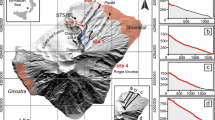Abstract
Pyroclastic flows generated in the 19–20 April 1993 eruption of Lascar Volcano, Chile, produced spectacular erosion features. Scree and talus were stripped from the channels and steep slopes on the flanks of the volcano. Exposed bedrock and boulders suffered severe abrasion, producing smoothed surfaces on coarse breccias and striations and percussion marks on bedrock and large boulders. Erosional furrows developed with wavelengths of 0.5–2 m and depths of 0.1–0.3 m. Furrows commonly nucleated downstream of large boulders or blocks, which are striated on the upstream side, and thereby produced crag-and-tail structures. Erosive features were produced where flows accelerated through topographic restrictions or where they moved over steep slopes. The pyroclastic flows are inferred to have segregated during movement into lithic-rich and pumice-rich parts. Lithic-rich deposits occur on slopes up to 14°, whereas pumice-rich deposits occur only on slopes less than 4°, and mainly at the margins and distal parts of the 1993 fan. The lithic-rich deposits contain large (up to 1 m) lithic clasts eroded from the substrate and transported from the vent, whereas pumice-rich deposits contain only small (typically <2 cm) lithic clasts. These observations suggest that lithic clasts segregated to the base of the flows and were responsible for much of the erosive phenomena. The erosive features, distribution of lithic clasts and deposit morphology indicate that the 1993 flows were highly concentrated avalanches dominated by particle interactions. In some places the flows slid over the bedrock causing abrasion and long striations which imply that large blocks were locked in fixed positions for periods of about 1 s. However, shorter striae at different angles, impact marks, segregation of the deposits into pumice- and lithic-rich parts, and mixing of bedrock-derived lithic clasts throughout the deposits indicate that clasts often had some freedom of movement and that jostling of particles allowed internal mixing and density segregation to occur within the flows.
Similar content being viewed by others
Author information
Authors and Affiliations
Additional information
Received: 15 July 1996 / Accepted: 15 January 1997
Rights and permissions
About this article
Cite this article
Sparks, R., Gardeweg, M., Calder, E. et al. Erosion by pyroclastic flows on Lascar Volcano, Chile. Bull Volcanol 58, 557–565 (1997). https://doi.org/10.1007/s004450050162
Issue Date:
DOI: https://doi.org/10.1007/s004450050162




